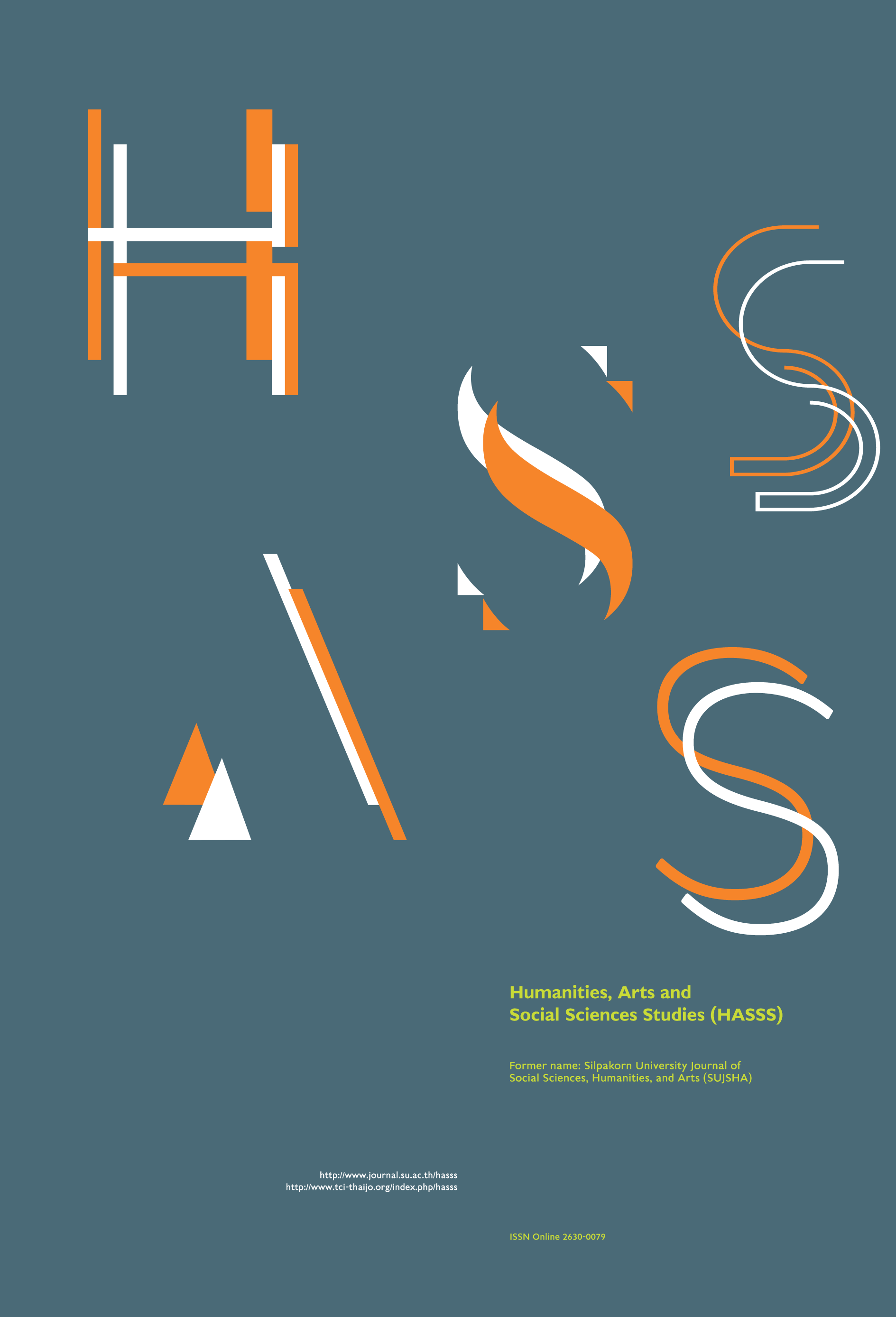The research and development of multi-interaction level in “enlightenment” virtual reality new media art
Main Article Content
Abstract
The main objectives of this research were (i) to study interaction level theory in Virtual Reality, (ii) to design and apply specific user interaction levels in Enlightenment Virtual Reality new media art and (iii) to observe and evaluate the effects of user interaction levels on the audience while viewing the Virtual Reality new media art. From the audience perspective, the level of user interaction in Virtual Reality can be classified into 3 categories: “Spectator”, “Actor”, and “Creator-Actor”. Based on these three criteria of the user role in viewing new media art, the researcher then designed a series of Enlightenment Virtual Reality arts depicting events of Buddha’s enlightenment. A comparative study by observing audience while experiencing 3 different levels of interaction reveals that 1. level of user interaction has direct variation to the amount of time audience spend viewing the artwork and 2. level of user interaction has direct variation to user’s physical engagement during the course of viewing the Virtual Reality artworks. The study reveals that by incorporating various user interaction levels in the artworks, the engagement level of the audience’s also increased accordingly. This study affirmed the importance of user interaction level for designing effective Virtual Reality new media art-viewing experience.
Downloads
Article Details
All rights reserved. Apart from citations for the purposes of research, private study, or criticism and review,no part of this publication may be reproduced, stored or transmitted in any other form without prior written permission by the publisher.
References
Ahmed, S. (2018). Interaction and Interactivity: In the Context of Digital Interactive Art Installation. In Human-Computer Interaction, edited by M. Kurosu, pp. 241-257. Cham: Springer.
Baukal, C., Ausburn, L. and Ausburn, F. (2013). A proposed multimedia cone of abstraction: updating a classic instructional design theory. Journal of Educational Technology 9(4): 15-24.
Bodhivides, U. (2019, June 4). Personal Interview.
Buddhadasa Bhikkhu (Ed.). (1972). Buddha's Biography. 8th ed. Bangkok: Karn Pim Phra Nakhon. [in Thai]
Dale, E. (1969). Audio-Visual Methods in Teaching. 3rd ed. New York: Dryden Press.
Harris, B. J. and Cline, E. (2019). The History of the Future: Oculus, Facebook, And the Revolution that Swept Virtual Reality. New York: Day Street Book.
Hirankerd, K. (2019, August 8). Personal Interview.
Hutchison, A. (2007). Back to the holodeck: new life for virtual reality? In K. K. W. Wong, L. Fung and P. Cole (Eds.), DIMEA ‘07: Proceedings of the 2nd International Conference on Digital Interactive Media in Entertainment and Arts, pp. 98-104. New York: Associate for Computing Machinery.
Karnchanapayap, G. and Chaetnalao, A. (2019a). Virtual reality sculpting-the quintessential sculpting medium of the digital era. Paper Presented at the 7th Burapha University International Conference on Interdisciplinary Research (BUU2019), Chonburi, November 27-29, 2019.
Karnchanapayap, G. and Chaetnalao, A. (2019b). Virtual simulacrum: reenacting immersive first-person experience through virtual reality animation. Paper Presented at the International Conference on Innovative Digital (ICID2019), Bangkok, November 21-23, 2019.
Oculus For Developers. (2021). Oculus Device Specifications. [Online URL: https://developer.oculus.com/learn/oculus-device-specs/] accessed on May 28, 2021.
Paramanuchitchinorot. (2011). Pathom Somphōthikathā. Bangkok: Thammasapa and Banluetham. [in Thai]
Penz, F., Radick G. and Howell R. (2004). Space: In Science, Art and Society. Cambridge: Cambridge University Press.
Quaranta, D. (2013). Beyond New Media Art. Brescia: Link Editions.
Ratchawej, O. (2019, August 9). Personal Interview.
Sarasalin, P. (2019, July 10). Personal Interview.
Somboon, J. (2019, August 17). Personal Interview.
Stevenson, A. (2010). Oxford Dictionary of English. New York: Oxford University Press.
Thaothong, P. (2019, July 23). Personal Interview.
Tingsanchali, C. (2019, August 16). Personal Interview.
Tisseau, J. (2001). Virtual Reality | In Virtuo Autonomy. Doctoral Dissertation. University of Rennes, France.
Viriyaburana, U. (n.d). 108 of Vedas Texts. Bangkok: Luk Sor Dhamma Pukdee. [in Thai]
Yoswatananont, N. (2019, September 4). Personal Interview.


